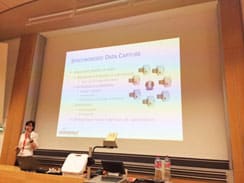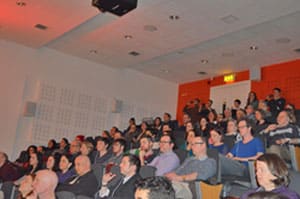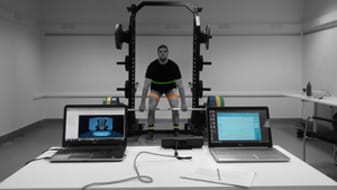Dublin, 21st May 2015 – The 12th Annual Body Sensor Networks (BSN) Conference is taking place on June 9-12th in Boston, USA. Shimmer will be in attendance as one of the industry experts to showcase the broad range of wearable sensing capabilities.
The 2015 conference will address BSN research and offers participants a unique forum to discuss key issues and innovative solutions for sensors, communications, algorithms, systems and applications. Building on the success of the previous 11 annual meetings, the conference will be held at the MIT Media Lab, Cambridge, MA.
Similar to previous years, Shimmer will be hosting a topical workshop event on Friday the 12th June based on ensuring ‘authenticity in sensing systems’. As well as hosting a stand during the 3 days of the conference. Members of the Shimmer team will be on hand to demonstrate our full range of wireless sensing hardware and supporting applications, and also get a sneak peak at our newest product offering Consensys, designed for efficient multi sensor management. Attendees will have the chance to interact with the latest applications and features of the Shimmer platform, and to discuss their use cases with our engineers.
Reserve Your Spot At The Workshop
Friday the 12th June at 9.00am, Shimmer will host a dynamic workshop in the area of sensor verification and validation. Exploring the themes of authenticity from hardware through to algorithm development. Download the agenda here
Dr. Niamh O’Mahony and Dr. Matthew Patterson will take attendees into the Shimmer system and identify the credibility behind the sensor that affects derived metrics and eventually user’s outcomes. In addition to this, the workshop will call on invited speakers to present their ongoing work in the area of accurate measurement for sensing systems based on the Shimmer platform. This will generate valuable discussions and add value to the area of authentic, validated sensing systems. The following abstracts provide a sneak preview into the topics you can expect to hear more about:
Stress Detection using Shimmer3 Biosensors –
C. Goumopoulos, Dynamic Ambient Intelligent Systems Unit, Computer Technology Institute and Press Diophantus, Patras, Greece, Information and Communication Systems Engineering Department, Aegean University, Samos, Greece.
In the ELTAB project we are examining tools to enhance the well-being of elderly people. In the case of elderly people, stress is the first symptom in the reaction of adaptation to physical disease that can then elaborate as depression. Physical disease in elderly usually is chronic and may deteriorate over time. In combination with other losses such as income, social status, death of friends and relatives can cause the development of adjustment disorder with depressive illness. Although there are effective methods of dealing with stress, this is often overlooked, underestimated or treated in the wrong way. Tools that can detect stress presence and provide reliable measurements in everyday environments are of paramount importance, both in a clinical context, to identify and monitor the progress of stress and in a research framework for its valid and reliable recording. Shimmer3 Platinum Development Kit is used to measure and log bio signals that are related to stress detection.
Individual Performance Calibration using Physiological Stress Signals – F. Hernando Gallego, Department of Signal Theory and Communications, Universidad Carlos III de Madrid, Madrid, Spain
The relation between performance and stress is described by the Yerkes-Dodson Law but varies significantly between individuals. The aim of this work is to use the Yerkes-Dodson Law to design an individual performance curve using physiological responses. We developed a method for determining the individual’s highest performance as a function of physiological signals. This method is based on Stroop-type color and mathematical operation tests. Four physiological signals are simultaneously monitored: Blood Volume Pressure (BVP), Galvanic Skin Response (GSR), Heart Rate (HR), and Electromyogram (EMG).
Use of Inertial Sensors and Depth Cameras for Application in Exercise Feedback and Functional Screening Tools – D. Whelan (1,2), M. O’Reilly (1,2), E. Delahunt (2), B. Caulfield (1,2) 1.Insight Centre for Data Analytics, University College Dublin 2.School of Public Health, Physiotherapy and Population Science, University College Dublin, Dublin, Ireland
Athletic screening is an important component of injury prevention and rehabilitation. However, screening can prove time consuming and the data collected is often unreliable. This leads to inefficient time management and poor decision-making. Recent developments in Inertial Measurement Units (IMUs) and Red Green Blue Depth (RGBD) cameras may allow for automated screening tools that can produce valid and reliable data. It is expected that by using sensor fusion techniques, inertial and RGBD sensor technologies will provide a comprehensive biomechanical analysis of human movement. These can then be adapted to aid the collection of data using common screening tools.
The Use of Inertial Sensors in Health Applications – K. Moran, E. Mitchell, School of Health and Human Performance, Dublin City University, Dublin, Ireland.
Between 37 and 70% of recreational runners sustain an overuse injury every year due to high impact forces and accelerations, produced when the foot strikes the ground. Given the unilateral (one-sided) nature of many injuries, asymmetrical running may be a primary cause of injury as associated compensatory actions could place excessive loads on tissues within the body. Alternatively, if not the cause, asymmetries may be an early indicator of an underlying injury. Either way, identifying running asymmetry may facilitate more effective injury detection and/or management.
Using Body Sensor Networks based on Shimmer Platform in Orthopedic Studies -M. Schulze (1), T. Calliess (2), R. Karkosch (2), R. Bocklage (2), H. Windhagen (2), M. Marschollek (1) 1.Peter L. Reichertz Institute for Medical Informatics, 2.Department of Orthopedic Surgery, Hannover Medical School, Hannover, Germany
Our main topics using Shimmer are fall prediction and motion analysis. Within the scope of outcome measurement after knee arthroplasty, ambulatory monitoring during daily activities can give insight into changes in activity level and can promote identifying medio-lateral instabilities of the knee joint and pathological motion patterns.Within our ongoing study “Partial Knee Clinics” we use 3 Shimmer2R (9DoF) devices attached to the patient’s sacrum, thigh and shank with kinesiotape while worn under normal clothes. Data sampled at 100Hz can either be (self-) calibrated, synchronized, recorded and annotated by self-developed software running on a windows tablet pc or directly be stored on SD card. We use R to calculate pelvis and knee angles, stability parameters as well as motion patterns; with a focus on joint function. In our next step, an unsupervised 24/7 field study, we will switch to Shimmer 3 (10DoF) devices as their gyroscope is able to detect angle velocity up to 2000 degrees per second and we appreciate the opportunity of having two accelerometers – one for wide range acceleration detection and another with ultra-low noise for accurate micro motion detection.
We look forward to seeing you there!
To contact us in advance or confirm your attendance at the workshop, please e-mails us at info@shimmersensing.com.
To register for the event contact BSN2015.




